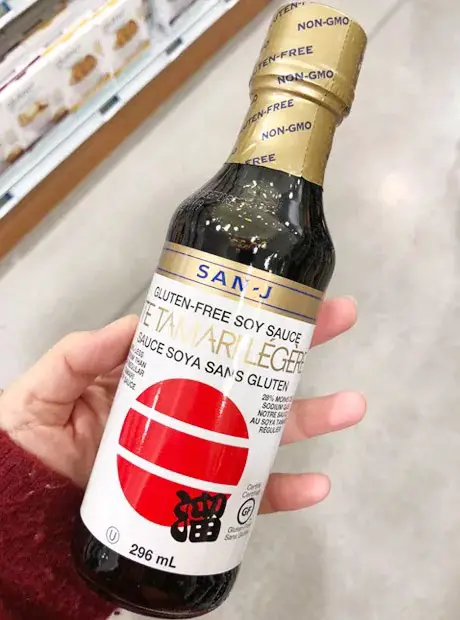We are reader supported. When you purchase through links on our site, we may earn an affiliate commission. Also, as an Amazon affiliate, we earn from qualifying purchases.

That sweet, spicy, salty, and savory tastes of sushi are possible due to the various types of sauces used in the preparation. This Japanese delicacy will not really taste like it does without the signature condiments that make it so special. It won’t be wrong to say that sauces are the lifeline of sushi.
While soy sauce (shoyu) is perhaps the first thing that comes to the mind when talking about sauces used in sushi, it is just the beginning. There are so many varieties available that it’s difficult to keep a count. They are mostly based on soy sauce and vary widely due to cultural influences.
Needless to say, many of these sauces look similar due to shoyu being the base ingredient. In this post, I will explain to you the difference between Nitsume (eel sauce) and Shoyu so that you can impress your friends with your knowledge and culinary expertise.
Contents
Nitsume Vs Shoyu
| Nitsume (Eel sauce) | Shoyu (soy sauce) | |
| Flavor | Has a distinct flavor of sweet mirin | Has a mild taste of salty soybeans |
| Color | Golden brown color | Reddish-brown color |
| Other names | Unagi or Kabayaki sauce | Tamari, White soy sauce |
| Composition | Made from sake, mirin, sugar, soy sauce, and dashi | Made from soybeans, salt, wheat, and water |
| Texture | Thicker inconsistency | Thinner consistency |
| Taste | Rich umami taste and flavor | Less umami than it’s darker versions |
| Type | Eel sauce is a prepared sauce | Shoyu is a seasoning sauce |
| Use | Typically used to glaze eel fillets in sushi | Used as a dipping sauce served with sushi |
| Ease of cooking | Easily prepared at home | Can be prepared at home, but it’s a lengthy process |
| Food pairing | Primarily used with eel, octopus and shrimp | Used with all types of fish, seafood, and vegetables |
If you have been to a sushi restaurant, you have probably noticed a dark syrupy sauce that tastes so good, you can almost lick it off the plate. This sauce is called Nitsume and it is typically served with the cooked sushi toppings such as shrimp, anago, and octopus.
In simple words, nitsume is more like a condensed form of sushi sauce. In the past, the recipe used for making this heavy and vicious sauce was a closely guarded secret as every restaurant had its own specialty. The Nitsume served at the restaurants differed a lot in taste and flavor. However, it has now become standardized and all sushi restaurants follow the same method.

The distinct flavor and sweet taste of nitsume typically arise from the use of mirin and anago (eel) broth. One of the oldest traditions of preparing the sauce was to allow eels to simmer in a pot filled with water for several months until a thick glaze was formed.
Recipe for Nitsume
This variant of soy sauce is called eel sauce for a reason. The traditional method of preparing Nitsume involved stock made from eel bones, however, it is now usually substituted for dashi or fish stock. If you would like to taste the real stuff and there are eel bones available, then here’s the recipe for you.
What you will need:
- Eel bones
- 1/2 cup Soy sauce
- 1/2 cup Mirin (sweet rice wine)
- 1/4 cup Sugar
Instructions
Remove the flesh part form the eel so that you only have bones in a bowl. Grill the eel bones and keep aside.
Measure out a half cup of rice wine and put it in a pan. Now, place the pan on high heat and let the wine reach a boiling point.
When the liquid starts boiling, add the grilled eel bones to the mixture and let the liquid simmer. Add half cup of soy sauce and white sugar to the pan. You may also use honey or brown sugar in the place of white sugar.
Let the mixture simmer for some time and keep stirring until the solids dissolve completely and the liquid is reduced to ¾ of the initial mixture.
When you notice that the liquid has turned thick and syrupy, filter out the eel bones. Let the sauce cool at room temperature before storing inside the fridge.
Vegan Recipe For Nitsume (Eel sauce)
If you find it difficult to find eel bones, you may substitute it with fish stock but what about those who are vegan. You don’t need to deprive your tastebuds of this delicacy. Here is an easy vegan nitsume recipe for you
What you will need:
- 1 ½ tablespoon sake
- 1/4 cup of mirin
- 2.5 tablespoon white sugar
- 1/4 cup of soy sauce
Instructions
Put sake, mirin, and sugar in a pan on medium heat and stir the mixture until the sugar dissolves completely. Add soy sauce to the pan and bring the mixture to boil
When the solution starts boiling, reduce the heat and let it simmer for 15-20 minutes or until it turns syrupy. The solution should turn to ¾ of the real quantity.
When a lot of bubbles start forming, remove the pan from heat and let the solution cool. Transfer the eel sauce to an airtight jar and store inside the fridge for up to two weeks. If you want to make the sauce thicker, add one tablespoon of cornstarch along with mirin and sake.
Gluten-Free Version Of Nitsume
If you are on a celiac diet, here’s presenting the gluten-free version for nitsume (eel sauce). Just remember to use tamari, the gluten-free version of soy sauce instead of shoyu.
What you will need:
- 2 tbsp of rice wine
- 2 tbsp tamari
- 2 tbsp sugar or honey
- 1 teaspoon fish sauce
- ½ cup of water
- 1 tbsp corn starch
Instructions
Put a small saucepan on the gas stove and add rice wine, honey, soy sauce, and fish sauce to it. Bring to boil and let it simmer for a few minutes.
Now, mix half a cup of water and corn starch to make a thick paste. Add it to the simmering mixture and let it cook until the sauce turns thick and syrupy. Allow it to cool and then transfer into an airtight container.
Shoyu: One Of The World’s Oldest Condiments
When you go to any Japanese or Chinese restaurant, the one thing that you will identify easily and find common is that dark brown sauce called shoyu (soy sauce). It won’t be wrong to say that oriental cuisine is incomplete without this savory liquid that imparts a characteristic taste to the dishes.
In almost every sushi restaurant, no matter how big or small, you will always find soya sauce served with sushi. The strong aroma of shoyu subdues the raw smell of fish and brings out the delicate flavors of this Japanese delicacy.
Shoyu’s Journey From China To Your Table
The soy sauce is one of the most popular condiments in the world today but it has a long history and there have been several evolutions throughout its journey. The sauce came to Japan from China where it was made using 100% soybeans.
When shoyu was introduced in Japan, the brewing method was slightly changed to include soybeans and wheat, resulting in a sweeter and smoother flavor. Japanese-made soy sauces are thinner and cleaner than their Chinese counterparts.
Interestingly, there are many varieties of shoyu to suit diverse tastes and cuisines. For example, a light soy sauce is used for the classic Chinese dishes, while a more intense shoyu with rich umami flavor is used for the Japanese dishes.
With a wide range of Japanese shoyu available in the market today, it’s essential for you to identify them by their flavor, color, and taste. The good quality sauce will have ‘naturally brewed’ printed on the package and the low-quality brands typically use chemicals and additives to imitate the real character of shoyu.
See more: What Are the Health Benefits of Soy Sauce?
5 Different Types Of Soy Sauce
Besides the method of brewing, soy sauce also varies widely in intensity and flavor. Here are the 5 types of soy sauce which may be slightly different from each other, but it is this difference that lends a unique flavor to each dish.
1. Light soy sauce: This is also known as the Chinese sauce, typically used in traditional Chinese dishes as a seasoning. It has a lighter color and thinner consistency than Japanese shoyu.
2. Dark soy sauce: It is known by its distinct caramel taste and mostly used in South-East Asian countries. The sauce is darker and much more flavorful than ordinary shoyu. It is used as a dipping sauce, table condiment or for making marinades.

3. Japanese Soy Sauce: This is the traditional shoyu made from soybeans, wheat, water, and salt. It has a milder taste and lends a full-bodied umami flavor to the Japanese dishes.
4. Tamari: This is the gluten-free variation of soy sauce where wheat is substituted with rice. People who have wheat intolerance should check the label to ensure that they buy tamari. It is less salty and makes a great dipping sauce for sushi. Many sushi restaurants carry tamari sauce to accommodate the special needs of people on a celiac diet.
5. Kecap Manis: This style of soy sauce is popularly used in Indonesian cuisine. It has a thicker consistency and richer texture.
Storage Tips For Shoyu
People tend to be careless with the storage of soy sauce, and this negligence can cause the condiment to develop fishy flavors. Hence, it’s important to store the soya sauce properly, especially after the bottle is opened.
Light and heat can quickly damage the flavor of the soy sauce, hence you need to store it away from heat, in a cool and dark place.
Once the bottle is opened, the shoyu should be stored inside the refrigerator and used within a month, more so if the sauce is in a clear bottle.
If you wish to store for longer, buy soy sauce that comes in a metal can. Store inside a dark cupboard and use it to refill a small glass bottle as and when needed.
Related Questions
Where can you buy Nitsume?
If you want to skip making nitsume at home, consider buying it from an Asian grocery store. You may also buy it online from sites like Amazon.
What are the other uses of Nitsume?
Besides using it as a glaze over eel, octopus, and shrimp, it can also be used with any grilled fish, chicken, or even mixed into noodles to enhance the flavor.
What’s the difference between shoyu and tamari?
Shoyu is the Japanese name for soy sauce and it is made from mashed soybeans and wheat. Tamari, on the other hand, is prepared by drawing the liquid content of soybean miso. It does not contain wheat, hence it is gluten-free
Related Article: Shoyu vs Tamari Detailed Explanation



